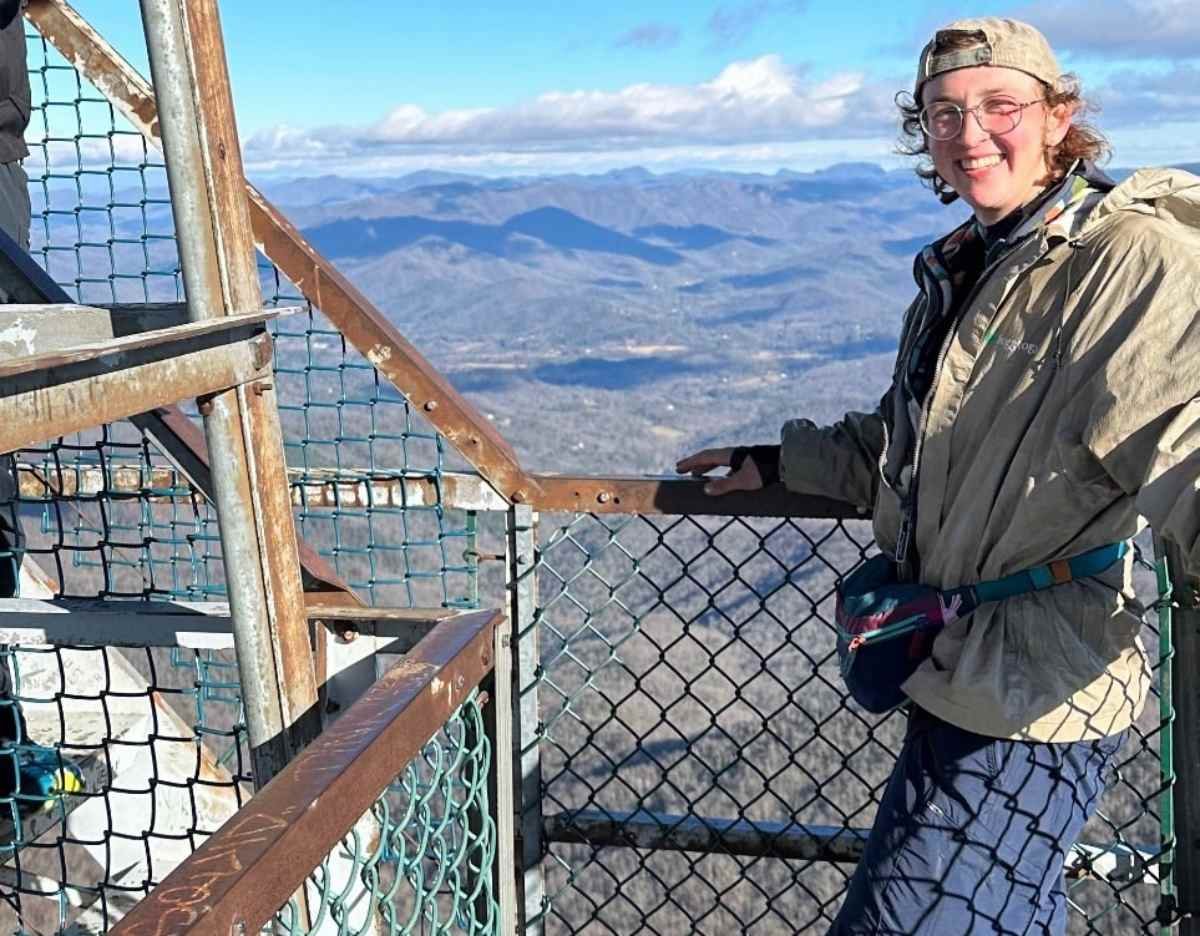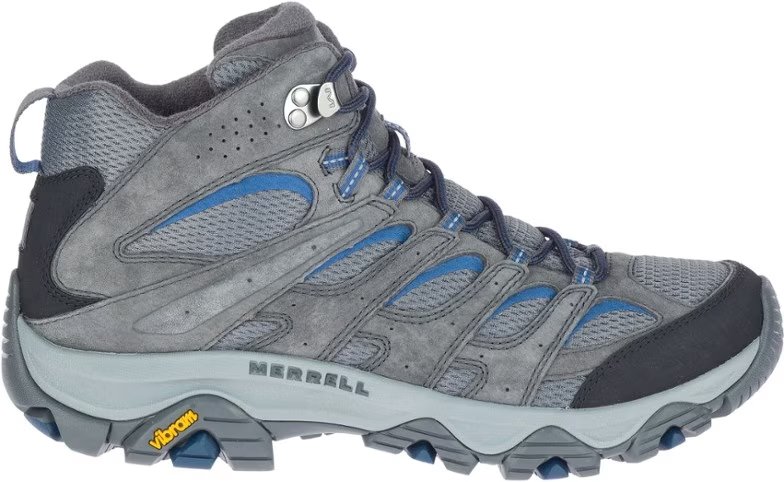Elliot’s Favorite Gear from the Appalachian Trail
Our writer’s 3 surprising favorite gear items for thru-hiking on a budget
Elliot in a Frogg Toggs jacket at the Georgia state border in December.
Home > News
Published February 8, 2024
The Appalachian Trail is the longest hiking-only footpath in the world at nearly 2200 miles, traveling through 14 states. It experiences the equivalent elevation gain and loss of climbing Mount Everest 16 times and takes a hiker through varied terrain as well as wide-ranging weather conditions.
My 2023 thru-hike of the Appalachian Trail was not only my first ever thru-hike but my first ever backpacking trip longer than one or two nights. While I researched what I should take ahead of time, the changing seasons and uncovering my preferred backpacking style contributed to my kit adapting frequently throughout the trek.
After 6 months on the trail, I discovered that remaining aware of the learning curve that comes with experience and fine-tuning gear preferences gradually were essential. As time went on, prioritizing gear versatility in changing terrain and weather conditions proved to be the key to dialing in my gear setup.
Here are my picks for gear items that I ended up sticking with.
We create reader-supported, objective gear reviews independently selected by our editors. This story may contain affiliate links, which help fund our website. When you click on the links to purchase gear, we may get a commission, without costing you an extra cent. Thank you for supporting our work and mission of outdoor coverage for every body! Learn more.
Elliot in his Black Diamond Cosmo 350-R Headlamp, ready for a night hike out of the NOC.
I underestimated the importance of a sufficiently bright headlamp for the first half of my thru-hike. The daylight of the summer – and my lower mileage at the outset of my hike – meant there was enough daylight to make it to camp without needing additional light on the way.
But finishing my hike in mid-December meant fewer hours of daylight to work with during the second half of my hike. Though I lacked prior experience with night hiking, it became a daily practice.
Starting and ending each day in the dark emphasized the importance of a reliable and adequately bright headlamp.
The headlamp I’d been using had begun to die unexpectedly and was almost comically dim, even with fresh batteries. After one particular night hike along a Tennessee ridgeline went awry, I found myself in the market for a new headlamp.
Enter the Black Diamond Cosmo 350-R Headlamp.
Right off the bat, this headlamp was a game-changer. It could shine brighter than I ever would need it to, making it ideal for even pitch-dark night hiking. Its red light setting could light up my whole tent, and both modes were easily adjustable. It didn’t take long to charge fully and held its charge well. Only once did I have to recharge it with my battery bank between trail towns, even with regular night hiking.
Primarily, I was just thrilled with its brilliance, especially after being frustrated with a faulty headlamp for so long.
For more great headlamp options, check out our guide on the Best Headlamps.
FROGG TOGGs ULTRA-LITE2 RAIN JACKET
Elliot used his Frogg Toggs Ultra-Lite2 jacket to stay warm in the sub-freezing temperatures and wind on the Albert Mountain Fire Tower.
I switched to a Frogg Toggs rain jacket about a thousand miles into my hike, and it became my favorite bargain gear item. Though I liked the rain jacket that I’d started the trail with (Outdoor Research Helium Jacket), it met its untimely end flying off the side of Old Speck in Maine during the high winds of Hurricane Lee. I needed a significantly cheaper replacement, and fast.
The moment I made it below treeline and got a phone signal, I ordered the cheapest Frogg Toggs I could find on Amazon Prime. It became one of my favorite pieces of gear and an integral part of my layering system.
My Frogg Toggs Ultra-Lite2 jacket kept me as dry as the Outdoor Research Helium at just a fraction of the cost. In warm weather, it was breathable enough that I didn’t overheat, and in winter, this helped keep cold sweat from accumulating inside the jacket.
It took up more space in my pack than the Helium, and the weight penalty compared to the Helium is 2.6 oz (8.8 oz vs. 6.2 oz). That said, once the temperatures dropped in late November and into December, I was wearing it so consistently that this became a non-issue.
I wore it just about whenever I stopped moving –on breaks, at camp, and even sometimes to sleep on especially cold nights, including almost every night in the Smokies. Though it survived the rest of the trip, I twice had to repair significant tears from the sleeves snagging on branches. So, while I found it to be an effective answer to my rain jacket search, its durability left something to be desired.
MERRELL MOAB 3 MID HIKING BOOTS
Merrell Moab 3 Mids were Elliot’s shoe of choice for over 2000 miles of the Appalachian Trail, all the way to the summit of Springer Mountain.
As a weak-ankled hiker who had only ever used heavy-duty hiking boots, I brazenly began my thru-hike in Altra Lone Peak trail running shoes (men's and women's), having heard that they’re a popular choice for a thru-hike. But Pennsylvania’s rocks humbled me quickly – I soon realized that zero-drop trail runners were not right for me.
After spraining my ankle and having to get off trail for a couple of weeks, I realized that I needed a sturdier, more structured shoe with ankle and arch support and a thicker sole. Intending to continue my thru-hike while minimizing foot and ankle pain, I started back on the trail in Merrell Moab 3 Mids and continued using them for the rest of my hike.
MEN'S
WOMEN'S
Making this switch right before hitting flooding in New Jersey and New York, I was concerned that my boots would not dry as quickly as my trail runners had, being heavier and thicker. While this proved true, the Moabs’ drying time was shorter than I’d expected because of how breathable the material is. And despite the Moabs being heavier – 13.6oz per shoe vs. the Altras’ 10.3oz per shoe – I experienced significantly less pain and could cover more ground than I had been able to in Altras.
As a burlier footwear solution than trail runners or hiking shoes that were still relatively lightweight, the Merrell Moab 3 Mids fulfilled and exceeded my expectations.
Curious about the merits of hiking shoes or trail running shoes? We have a guide to Trail Running Shoes vs Hiking Shoes to help you determine the best option for you.
WHY YOU SHOULD TRUST US
Elliot Koeppel is a recent graduate of Tufts University with a B.A. in History. He finished his first-ever thru-hike of the Appalachian Trail in December 2023. In his free time, he can be found drawing, watercolor painting, making jewelry, listening to Van Halen, and acquiring tattoos of the sickest birds known to man.
To see all of Elliot's stories, check his author page










